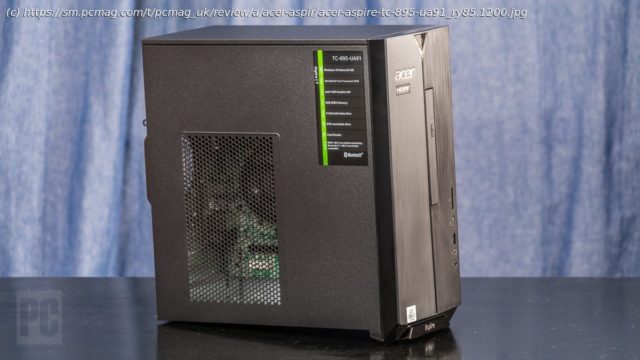A budget mini tower balanced just about right
Acer’s Aspire TC-895-UA91 ($429.99) is, in many ways, just what most budget desktop shoppers are looking for. Affordable, compact, and fully featured, this basic mini tower includes the essentials, plus some extras that its like-priced competitors lack. Packing a “true” desktop-strength 10th Generation Intel Core i3 processor with legitimately capable performance, a 512GB SSD, and support for USB Type-C, SD cards, Wi-Fi, and Bluetooth, this basic PC has nothing major missing and a lot to like. (Some closely priced machines rely on lesser laptop-grade CPUs.) This combination of processing pep and feature set tops the competition on value, earning this Aspire our first 2021 Editors’ Choice award for budget desktops. A No-Fuss Design You can tell at a glance that this desktop is about the basics, and for this category and at this price, that’s perfectly okay. From its relatively compact size to its modest look, there’s nothing about the design that screams “powerhouse” or “flair.” The look is inoffensive, and unless an all-black device clashes with your décor, it will blend in fine with your office or bedroom setup. It won’t take up much space on your desk or floor for a traditional tower, either, at 13.4 by 6.4 by 13.8 inches (HWD). The competing HP Slim Desktop (10.6 by 3.7 by 11.9 inches) and Lenovo IdeaCentre 3 (11.8 by 3.9 by 10.6 inches) are even more compact, but that’s fair enough when they’re even less expensive (and less powerful), especially when one has “slim” right in the name. (These machines, as alluded to above, are based on lesser-powered laptop processors.) Internal access is about as simple as the rest of the build. Removing two rear screws allows you to pull the left side panel off the chassis, granting access to a basic interior. About one third is blocked off by a metal backplate, onto which you could mount additional hard drives. (A spare SATA power connector is hanging near, as are several SATA data connectors on the motherboard.) Behind that is the housing for the DVD drive, and beneath that (on the motherboard) the 512GB M.2 SSD. In the unobscured area, you can see the rest of the motherboard, including the mounted CPU air cooler. The power supply is contained in the top left corner. Above-Average Features The setup in our unit includes an Intel Core i3-10100 processor,8GB of memory, and the 512GB of storage. There’s a little room for expansion in terms of memory—ours is configured with a single 8GB stick, and there’s a free slot next to it. The board maxes out at 32GB of memory. There isn’t a huge amount of expansion possible, all in all, but if you do need to do maintenance or some upgrades, there’s plenty of space inside. Ultimately, aside from perhaps adding more RAM, this is meant to be an affordable plug-and-play solution, so DIY upgrades are not the priority. This motherboard does include a PCI Express x16 slot, but your options for adding a graphics card are limited. Aside from the size restriction of the case for larger GPUs (you have about 6 inches of clearance from the PCI card backplane to the metal drive frame in front), the included power supply unit (PSU) is only 300 watts. It uses non-standard power connections to juice the mainboard, however (no standard 24-pin ATX power connection), so swapping in a different, higher-watt PSU to power a beefy graphics card is a no-go, or at least not easy. A low-powered, slot-power-only video card could be a solution, but you’re otherwise restricted. Some calculations we did on the venerable Outervision PSU Calculator suggest you could squeak in a GeForce GTX 1650 card with the PSU in this configuration, provided the card is short enough and doesn’t need a dedicated power connector. From here we move on to connectivity, a crucial part of any desktop.






